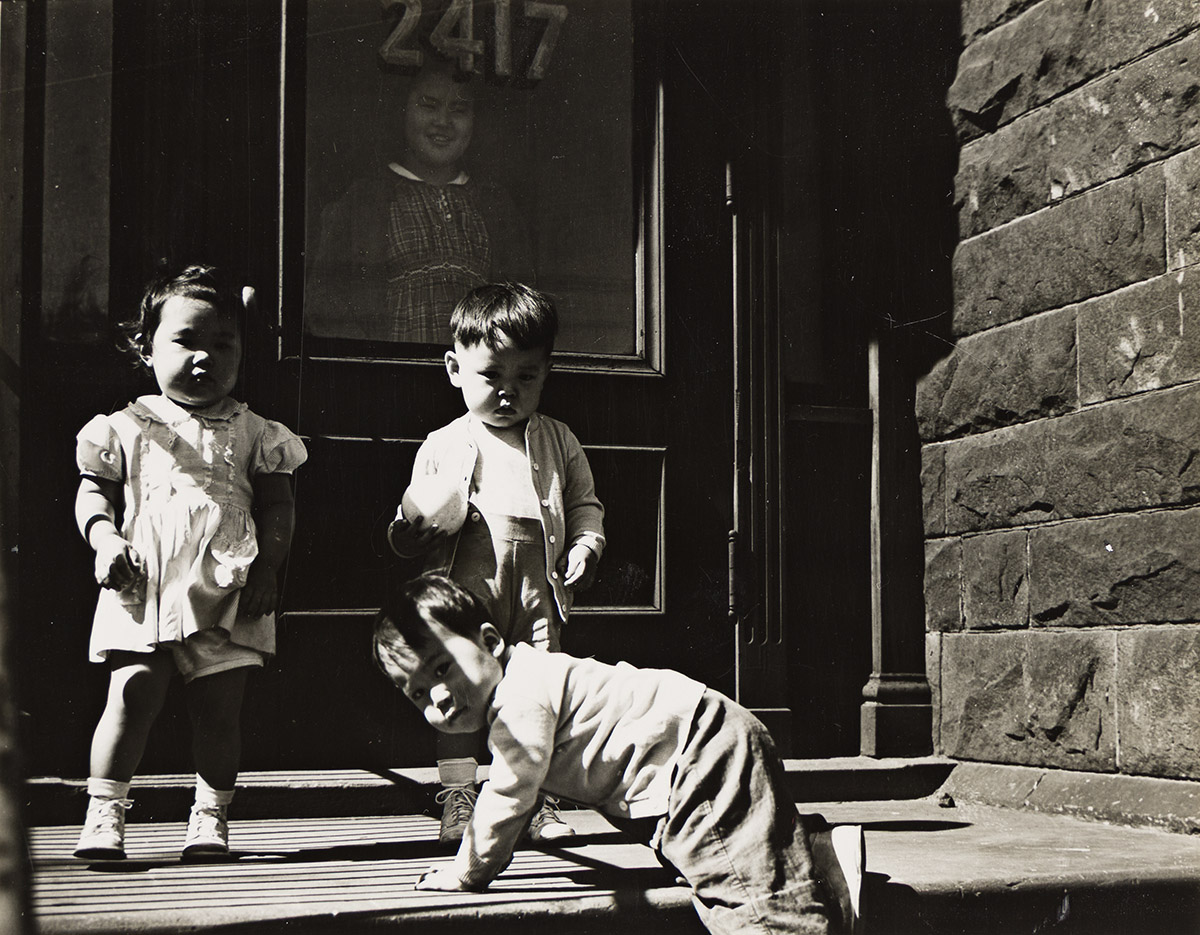Sale 2703 - Lot 69
Unsold
Estimate: $ 600 - $ 900
GODFREY FRANKEL (1912-1995)
Japanese-American Children, Cleveland. Circa 1945.
Silver print, the image measuring 4x5⅛ inches (10.2x1 cm.), with Frankel's signature, his Cleveland address, and the title in ink, and his extensive caption, and print date (1945) in pencil, on verso.
Provenance
Acquired from the Photographer's son; to a Private Collection in New Jersey
The full caption reads as follows: "Among the early families who were relocated to Cleveland from a War relocation center in the west."
In 1943 Frankel moved to Washington, D.C. in order to document the African American community there in photographs, imagery that is joyful, intimate, and direct. He was employed by the War Relocation Authority, photographing Heart Mountain Relocation Center in Wyoming (1945), the infamous internment camp where Japanese Americans were imprisoned. After the end of the war he moved to New York and joined the Photo League, and his work was included in the group exhibition "New Photographers," at the Museum of Modern Art, New York (1946).
The Photo League was a cooperative of amateur and professional photographers for whom socially conscious photography was a powerful and expressive tool to both document and explore the human condition. Without espousing a particular aesthetic, the Photo League's members created imagery that was informed by both interest in and interrogation of documentary techniques, as well as a sharp aesthetic perspective. Over the course of 15 short by intense years, which saw the end of the Great Depression, WWII, and political transformation, the leftist and radical Leage elevated and interrogated social realism, the role of the photographer, pushed street photography to new levels, while simultaneously contributing significantly to advocating for photography as an art form.
The group had its origins in the Film and Photo League, an offshoot of Workers International Relief, which was an organization that supplied the left-wing press with images of working-class life. The filmmakers, under Paul Strand, eventually formed the production company Frontier Films. The photographers, led by Sid Grossman and Sol Libsohn, founded the Photo League in 1936 (Berenice Abbott and Strand named the group). Initially operating out of a loft on East 21st Street, the Photo League provided members with low-cost darkroom facilities and technical instruction. The League also published a newsletter called Photo Notes, offered courses in photographic history, sponsored lectures, and organized social activities such as "Photo Hunts" and "Crazy Camera Balls." In addition to the photographs represented here, the group included or was supported by photographers such as Ruth Orkin, Louis Stettner, Margaret Bourke-White, Aaron Siskind, Arthur Leipzig, Ruth Orkin, W. Eugene Smith, Arthur Rothstein, Richard Avedon, Weegee, Robert Frank, Ansel Adams, Edward Weston, and many more.
In 1947, the League was blacklisted under McCarthyism, for its alleged involvement with the Communist Party. Despite support by prominent photographers, a passionate issue of Photo Notes, and an exhibition This is the Photo League, the group could not overcome the powerful sweep of the Red Scare and was forced to disband in 1951.
Japanese-American Children, Cleveland. Circa 1945.
Silver print, the image measuring 4x5⅛ inches (10.2x1 cm.), with Frankel's signature, his Cleveland address, and the title in ink, and his extensive caption, and print date (1945) in pencil, on verso.
Provenance
Acquired from the Photographer's son; to a Private Collection in New Jersey
The full caption reads as follows: "Among the early families who were relocated to Cleveland from a War relocation center in the west."
In 1943 Frankel moved to Washington, D.C. in order to document the African American community there in photographs, imagery that is joyful, intimate, and direct. He was employed by the War Relocation Authority, photographing Heart Mountain Relocation Center in Wyoming (1945), the infamous internment camp where Japanese Americans were imprisoned. After the end of the war he moved to New York and joined the Photo League, and his work was included in the group exhibition "New Photographers," at the Museum of Modern Art, New York (1946).
The Photo League was a cooperative of amateur and professional photographers for whom socially conscious photography was a powerful and expressive tool to both document and explore the human condition. Without espousing a particular aesthetic, the Photo League's members created imagery that was informed by both interest in and interrogation of documentary techniques, as well as a sharp aesthetic perspective. Over the course of 15 short by intense years, which saw the end of the Great Depression, WWII, and political transformation, the leftist and radical Leage elevated and interrogated social realism, the role of the photographer, pushed street photography to new levels, while simultaneously contributing significantly to advocating for photography as an art form.
The group had its origins in the Film and Photo League, an offshoot of Workers International Relief, which was an organization that supplied the left-wing press with images of working-class life. The filmmakers, under Paul Strand, eventually formed the production company Frontier Films. The photographers, led by Sid Grossman and Sol Libsohn, founded the Photo League in 1936 (Berenice Abbott and Strand named the group). Initially operating out of a loft on East 21st Street, the Photo League provided members with low-cost darkroom facilities and technical instruction. The League also published a newsletter called Photo Notes, offered courses in photographic history, sponsored lectures, and organized social activities such as "Photo Hunts" and "Crazy Camera Balls." In addition to the photographs represented here, the group included or was supported by photographers such as Ruth Orkin, Louis Stettner, Margaret Bourke-White, Aaron Siskind, Arthur Leipzig, Ruth Orkin, W. Eugene Smith, Arthur Rothstein, Richard Avedon, Weegee, Robert Frank, Ansel Adams, Edward Weston, and many more.
In 1947, the League was blacklisted under McCarthyism, for its alleged involvement with the Communist Party. Despite support by prominent photographers, a passionate issue of Photo Notes, and an exhibition This is the Photo League, the group could not overcome the powerful sweep of the Red Scare and was forced to disband in 1951.

Exhibition Hours
Exhibition Hours
Aliquam vulputate ornare congue. Vestibulum maximus, libero in placerat faucibus, risus nisl molestie massa, ut maximus metus lectus vel lorem.


